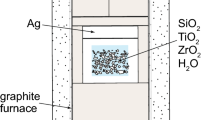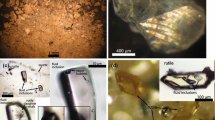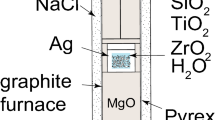Abstract
Quartz and rutile were synthesized from silica-saturated aqueous fluids between 5 and 20 kbar and from 700 to 940°C in a piston-cylinder apparatus to explore the potential pressure effect on Ti solubility in quartz. A systematic decrease in Ti-in-quartz solubility occurs between 5 and 20 kbar. Titanium K-edge X-ray absorption near-edge structure (XANES) measurements demonstrate that Ti4+ substitutes for Si4+ on fourfold tetrahedral sites in quartz at all conditions studied. Molecular dynamic simulations support XANES measurements and demonstrate that Ti incorporation onto fourfold sites is favored over interstitial solubility mechanisms. To account for the P–T dependence of Ti-in-quartz solubility, a least-squares method was used to fit Ti concentrations in quartz from all experiments to the simple expression
where R is the gas constant 8.3145 J/K, T is temperature in Kelvin, \( X_{{{\text{TiO}}_{ 2} }}^{\text{quartz}} \) is the mole fraction of TiO2 in quartz and \( a_{{{\text{TiO}}_{ 2} }} \) is the activity of TiO2 in the system. The P–T dependencies of Ti-in-quartz solubility can be used as a thermobarometer when used in combination with another thermobarometer in a coexisting mineral, an independent P or T estimate of quartz crystallization, or well-constrained phase equilibria. If temperature can be constrained within ±25°C, pressure can be constrained to approximately ±1.2 kbar. Alternatively, if pressure can be constrained to within ±1 kbar, then temperature can be constrained to approximately ±20°C.









Similar content being viewed by others
References
Anderson AT Jr, Crewe AV, Goldsmith JR, Moore PB, Newton RC, Olsen EJ, Smith JV, Wyllie PJ (1970) Petrologic history of Moon suggested by petrography, mineralogy, and crystallography. Science 167:587–590
Anderson AT Jr, Davis AM, Lu F (2000) Evolution of bishop tuff rhyolitic magma based on melt and magnetite inclusions and zoned phenocrysts. J Petrol 41:449–473
Andreoni W, Curioni A (2000) New advances in chemistry and materials science with CPMD and parallel computing. Parallel Comput 26:819–842
Bair RA, Goddard WA (1980) Ab initio studies of the X-ray absorption edge in copper complexes. l. Atomic Cu2+ and Cu(II)Cl2. Phys Rev B 22:2767–2776
Bekas C, Curioni A (2008) Atomic wavefunction initialization in ab initio molecular dynamics using distributed Lanczos. Parallel Comput 34:441–450
Berry AJ, Walker AM, Hermann J, HStC O’Neill, Foran GF, Gale JD (2007) Titanium substitution in forsterite. Chem Geol 242:176–186
Breecker DA (2001) Mineral assemblages in high-pressure quartz-mica schists from Syros, Cyclades, Greece. Unpublished BA Thesis, Amherst College, p 70
Cherniak DJ (2006) Zr diffusion in titanite. Contrib Mineral Petrol 152:639–647
Cherniak DJ, Watson EB, Wark DA (2007a) Ti diffusion in quartz. Chem Geol 236:65–74
Cherniak DJ, Manchester J, Watson EB (2007b) Zr and Hf diffusion in rutile. Earth Planet Sci Lett 261:267–279
Denen WH (1964) Impurities in quartz. Geol Soc Am Bull 75:241–246
Denen WH (1966) Stoichiometric substitution in natural quartz. Geochim Cosmochim Acta 30:1235–1241
Farges F (1997) Coordination of Ti4+ in silicate glasses: a high-resolution XANES spectroscopy study of the Ti K edge. Am Mineral 82:36–43
Farges F, Brown GE Jr, Rehr JJ (1996a) Coordination chemistry of Ti(IV) in silicate glasses and melts: I. XAFS study of titanium coordination in oxide compounds. Geochim Cosmochim Acta 60:3023–3038
Farges F, Brown GE Jr, Rehr JJ (1996b) Coordination chemistry of Ti(IV) in silicate glasses and melts: II. Glasses at ambient temperature and pressure. Geochim Cosmochim Acta 60:3039–3053
Farges F, Brown GE Jr, Rehr JJ (1997) Ti K-edge XANES studies of Ti coordination and disorder in model compounds: comparison between theory and experiment. Phys Rev B 56:1809–1819
Ferris EDA, Essene EJ, Becker U (2008) Computational study of the effect of pressure on the Ti-in-zircon geothermometer. Eur J Mineral 20:745–755
Ferry JM, Watson EB (2007) New thermodynamic models and revised calibrations for the Ti-in-zircon and Zr-in-rutile thermometers. Contrib Mineral Petrol 154:429–437
Ghent ED, Stout MZ (1984) TiO2 activity in metamorphosed pelitic and basic rocks: principles and applications to metamorphism in southeastern Canadian Cordillera. Contrib Mineral Petrol 86:248–255
Ghisoro MS, Evans BW (2008) Thermodynamics of rhombohedral oxide solid solutions and a revision of the Fe-Ti two-oxide geothermometer and oxygen-barometer. Am J Sci 308:957–1039
Hayden LA, Watson EB, Wark DA (2007) A thermobarometer for sphene (titanite). Contrib Mineral Petrol 155:529–540
Hildreth W, Wilson CJN (2007) Compositional zoning of the bishop tuff. J Petrol 48:951–999
Holtz F, Johannes W (1994) Maximum and minimum water contents of granitic melts: implications for chemical and physical properties of ascending magmas. Lithos 32:149–159
Kennedy GC, Wasserburg GJ, Heard HC, Newton RC (1962) The upper three-phase region in the SiO2–H2O system. Am J Sci 260:501–521
Kresse G, Furthmuller J (1996) Efficiency of ab initio total energy calculations for metals and semiconductors using a plane-wave basis set. Computat Mat Sci 6:15–50
Landtwing M, Petke T (2005) Relationships between SEM-cathodoluminescence response and trace element composition of hydrothermal vein quartz. Am Mineral 90:122–131
Levien L, Prewitt CT, Weidner DJ (1980) Structure and elastic properties of quartz at pressure. Am Mineral 65:920–930
Lowers HA, Rusk BG, Koenig A (2007) Application of the titaniq geothermometer to hydrothermal quartz. GSA Denver Annual Meeting abstract, pp 226–229
Moneke T, Kempe U, Götze J (2002) Genetic significance of trace element content in metamorphic and hysrothermal quartz: a reconnaissance study. Earth Planet Sci Lett 202:709–724
Müller A, Wiedenbeck M, Van den Kerkhof AM, Kronz A, Simon K (2003) Trace elements in quartz-A combined electron microprobe, secondary ion mass spectrometry, laser ablation ICPMS and cathodoluminescence study. Eur J Mineral 15:747–763
Ostapenko GT, Gamarnik MY, Gorogotskaya LI, Kuznetsov GV, Tarashchan AN, Timoshkova LP (1987) Isomorphism of titanium substitution for silicon in quartz: experimental data. Mineral Zh 9:30–40
Ostapenko GT, Tarashchan AN, Mitsyuk BM (2007) Rutile-quartz geothermobarometer. Geochem Int 45:506–508
Paier J, Hirschl R, Marsman M, Kresse G (2005) The Perdew–Burke–Ernzerhof exchange-correlation functional applied to the G2–1 test set using a plane-wave basis set. J Chem Phys 122:234102
Peppard BT, Steele IM, Davis AM, Wallace PJ, Anderson AT (2001) Zoned quartz phenocrysts from the rhyolitic bishop tuff. Am Mineral 86:1034–1052
Perdew JP, Burke K, Ernzerhof M (1996) Generalized gradient approximation made simple. Phys Rev Lett 77:3865–3868
Philpotts AR (1990) Principles of igneous and metamorphic petrology. Prentice Hall, Englewood Cliffs
Ravel B, Newville M (2005) ATHENA, ARTEMIS, HEPHAESTUS: data analysis for X-ray absorption spectroscopy using IFEFFIT. J Synchrotron Radiat 12:537–541
Reid MR, Vazquez JA, Schmitt AK (2010) Zircon-scale insights into the history of a supervolcano, Bishop Tuff, Long Valley, California—with implications for the Ti-in-zircon geothermometer. Contrib Mineral Petrol (accepted)
Rusk BG, Reed MH, Dilles JH, Kent AJR (2006) Intensity of quartz cathodoluminescence and trace-element content in quartz from the porphyry copper deposit at Butte, Montana. Am Mineral 91:1300–1312
Shen AH, Bassett WA, Chou I-M (1993) The α-β quartz transition at high temperatures and pressures in a diamond anvil cell by laser interferometry. Am Mineral 78:694–698
Spear FS (1993) Metamorphic phase equilibria and pressure-temperature-time paths. Mineralogical Society of America, Washington
Spear FS, Wark DA (2009) Cathodoluminescence imaging and titanium thermometry metamorphic quartz. J Metamorph Geol 27:187–205
Spear FS, Cheney JT, Wark DA (2005) Application of accessory phase/trace element thermometry to blueschists from Syros and Sifnos, Greece. Geochim Cosmochim Acta 69 (Goldschmidt Conf Abstr):A25
Spear FS, Wark DA, Cheney JT, Schumaker JC, Watson EB (2006) Zr-in-rutile thermometry in blueschists from Sifnos, Greece. Contrib Mineral Petrol 152:375–385
Sprunt ES (1981) Causes of quartz cathodoluminescence colors. Scan Electron Microsc 1981:525–535
Suttner LJ, Leininger RK (1972) Comparison of trace element content of plutonic, volcanic and metamorphic quartz from southwestern Montana. Bull Geol Soc Am 83:1855–1862
Tailby ND, Walker AM, Berry AJ, Hermann J, Evans KA, Mavrogenes JA, O’Neill H St C, Rodina IS, Soldatov AV, Rubatto D, Sutton SR (2010) Ti site occupancy in zircon. Geochim Cosmochim Acta (in press)
Tomkins HS, Powell R, Ellis DJ (2007) The pressure dependence of the zirconium-in-rutile thermometer. J Metamorph Geol 25:703–713
Troullier N, Martins JL (1991) Efficient pseudopotentials for plane-wave calculations. II. Operators for fast iterative diagonalization. Phys Rev B Cond Matter 43:8861
Wallace P, Anderson AT, Davis AM (1999) Gradients in H20, CO2, and exsolved gas in a large-volume silicic magma system: interpreting the record preserved in melt inclusions from the Bishop Tuff. J Geophys Res 104:20097–20122
Wark DA, Spear FS (2005) Titanium in quartz: cathodoluminescence and thermometry. Geochim Cosmochim Acta 69:A592
Wark DA, Watson EB (2006) The TitaniQ: a Titanium-in-quartz geothermometer. Contrib Mineral Petrol 152:743–754
Wark DA, Hildreth W, Spear FS, Cherniak DJ, Watson EB (2007) Pre-eruption recharge of the bishop magma system. Geology 35:235–238
Watson EB, Wark DA, Price JD, Van Orman JA (2002) Mapping the thermal structure of solid-media pressure assemeblies. Contrib Mineral Petrol 142:640–652
Watson EB, Wark DA, Thomas JB (2006) Crystallization thermometers for zircon and rutile. Contrib Mineral Petrol 151:413–433
Waychunas GA (1987) Synchrotron radiation XANES spectroscopy of Ti in minerals: effects of Ti bonding distances, Ti valence, and site geometry on absorption edge structure. Am Mineral 72:89–101
Wiebe RA, Wark DA, Hawkins DP (2007) Insights from quartz cathodoluminescence zoninginto crystallization of the Vinalhaven granite, coastal Maine. Contrib Mineral Petrol 154:439–453
Zicovich-Wilson CM, Pascale F, Roetti C, Saunders VR, Orlando R, Dovesi R (2004) Calculation of the vibration frequencies of α-quartz: the effect of Hamiltonian and basis set. J Computat Chem 25:15
Acknowledgments
This work was supported by the Earth Sciences Division of the National Science Foundation through grant number EAR-0440228 to EBW. PTS thanks Dr. Alessandro Curioni for helpful discussions, the Interconnect Focus Center for funding, and the Computational Center for Nanotechnology Innovations (CCNI) at RPI for supercomputer access. Beamline X-26A at the NSLS is supported by the Department of Energy (DOE)—Geosciences through grant number DE-FG02-92ER14244 to The University of Chicago—CARS. The XANES measurements at NSLS would not have been possible without the dedicated assistance of William Rao. Reviews by John Ferry, John Mavrogenes and Roger Powell helped improve the final version of the manuscript.
Author information
Authors and Affiliations
Corresponding author
Additional information
Communicated by T. L. Grove.
Appendix
Appendix
The equation to convert Ti (ppm) to mole fraction TiO2 in quartz (\( X_{{{\text{TiO}}_{ 2} }}^{\text{quartz}} \)) is
The equation to convert Zr (ppm) to mole fraction ZrO2 in rutile (\( X_{{{\text{ZrO}}_{ 2} }}^{\text{rutile}} \)) is
The equation to convert Zr (ppm) to mole fraction ZrO2 in sphene (\( X_{{{\text{ZrO}}_{ 2} }}^{\text{sphene}} \)) is
Rights and permissions
About this article
Cite this article
Thomas, J.B., Bruce Watson, E., Spear, F.S. et al. TitaniQ under pressure: the effect of pressure and temperature on the solubility of Ti in quartz. Contrib Mineral Petrol 160, 743–759 (2010). https://doi.org/10.1007/s00410-010-0505-3
Received:
Accepted:
Published:
Issue Date:
DOI: https://doi.org/10.1007/s00410-010-0505-3




